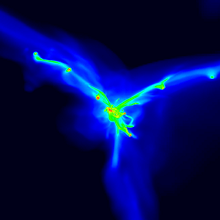Avishai Dekel
Avishai Dekel (born 1951) is a professor of physics at the Hebrew University of Jerusalem, Israel, holding the Andre Aisenstadt Chair of Theoretical Physics. His primary research interests are in astrophysics and cosmology.
| Avishai Dekel | |
|---|---|
 | |
| Born | 13 January 1951 Jerusalem |
| Alma mater | |
| Occupation |
|
| Website | http://www.phys.huji.ac.il/~dekel |
| Scientific career | |
| Fields | Cosmology, astrophysics |
| Institutions |
|


Academic career
Dekel earned his Ph.D. from the Hebrew University in 1980, and was a research fellow at Caltech and assistant professor at Yale University before joining the faculty of the Hebrew University in 1986.
He served as the Head of The Racah Institute of Physics (1997–2001), the Dean of the Authority for the Community and Youth at the Hebrew University (2005–2011), and the President of the Israel Physical Society (2008–11). He headed the university computing committee, was a member of the executive committee of the board of trustees and a member of the standing committee of the Hebrew University.
Dekel was awarded a Visiting Miller Professorship[1] at UC Berkeley, a Blaise Pascal International Chair of Research by the École Normale Supérieure in Paris (2004–06), and a Lagrange fellowship in IAP Paris (2015–16).
Dekel is known for his contributions to research in cosmology, especially the study of the formation of galaxies and large-scale structure in the Universe, which is dominated by dark energy and dark matter. [2][3] His expertise is dwarf galaxies and supernova feedback (1986, 2003), large-scale cosmic flows and early estimates of fundamental cosmological parameters (1989-2001), [4] the structure of dark-matter galactic halos (2000–2003), and the theory of galaxy formation (2003–2012). [5][6]
His research focuses on galaxy formation in its most active phase at the early universe, using analytic models and computer simulations. He studies how continuous streams of cold gas and merging galaxies from the cosmic web lead to star-forming disks and drive violent gravitational disk instability, and how this instability leads to the formation of compact spheroidal galactic components with central massive black holes.
References
- "Miller Institute - Visiting Professorship list". miller.berkeley.edu. Retrieved 2016-10-21.
- Alan P. Lightman (1993), Ancient Light: Our Changing View of the Universe, Harvard University Press, p. 134, ISBN 978-0-674-03363-4
- M. S. Longair (2006), The cosmic century: a history of astrophysics and cosmology, Cambridge University Press, p. 360, ISBN 978-0-521-47436-8
- "More evidence for the accelerating universe", Physics World, Institute of Physics, 17 September 1999, retrieved 12 December 2012
- Eric Hand (1 April 2009), "Early galaxies surprise with size", Nature News, doi:10.1038/news.2009.225
- Rachel Courtland (21 January 2009), "Dark matter filaments stoked star birth in early galaxies", New Scientist, retrieved 12 December 2012